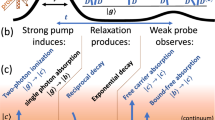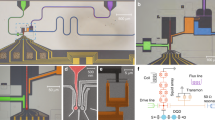Abstract
Quantum bits1,2,3,4,5 (qubits) are the fundamental building blocks of quantum information processors, such as quantum computers6. A qubit comprises a pair of well characterized quantum states that can in principle be manipulated quickly compared to the time it takes them to decohere by coupling to their environment7. Much remains to be understood about the manipulation and decoherence of semiconductor qubits. Here we show that hydrogen-atom-like motional states of electrons bound to donor impurities in currently available semiconductors can serve as model qubits. We use intense pulses8 of terahertz radiation to induce coherent, damped Rabi oscillations9,10 in the population of two low-lying states of donor impurities in GaAs11,12,13. Our observations demonstrate that a quantum-confined extrinsic electron in a semiconductor can be coherently manipulated like an atomic electron, even while sharing space with ∼105 atoms in its semiconductor host. We anticipate that this model system will be useful for measuring intrinsic decoherence processes, and for testing both simple and complex manipulations of semiconductor qubits.
This is a preview of subscription content, access via your institution
Access options
Subscribe to this journal
Receive 51 print issues and online access
$199.00 per year
only $3.90 per issue
Buy this article
- Purchase on Springer Link
- Instant access to full article PDF
Prices may be subject to local taxes which are calculated during checkout




Similar content being viewed by others
References
Loss, D. & DiVincenzo, D. P. Quantum computation with quantum dots. Phys. Rev. A 57, 120–126 (1998).
Kane, B. E. A silicon-based nuclear spin quantum computer. Nature 393, 133–137 (1998).
Sherwin, M. S., Imamoglu, A. & Montroy, T. Quantum computation with quantum dots and terahertz cavity quantum electrodynamics. Phys. Rev. A 60, 3508–3514 (1999).
Imamoglu, A. et al. Quantum information processing using quantum dot spins and cavity QED. Phys. Rev. Lett. 83, 4204–4207 (1999).
Vrijen, R. et al. Electron spin resonance transistors for quantum computing in silicon-germanium hetero-structures. Preprint quant-ph/9905096 at http://xxx.lanl.gov (1999).
Bennett, C. H. & DiVincenzo, D. P. Quantum information and computation. Nature 404, 247–255 (2000).
DiVincenzo, D. P. Quantum computation. Science 270, 255–261 (1995).
Hegmann, F. A. et al. Time-resolved photoresponse of a gallium-doped germanium photoconductor using a variable pulse-width terahertz source. Appl. Phys. Lett. 76, 262–264 (2000).
Rabi, I. I. Space quantization in a gyrating magnetic field. Phys. Rev. 51, 652–654 (1937).
Boyd, R. W. Nonlinear Optics (Academic, Boston, 1992).
Kohn, W. in Solid State Physics (eds Seitz, F. & Turnbull, D.) Vol. 5, 257–320 (Academic, New York, 1957).
Yu, P. Y. & Cardona, M. Fundamentals of Semiconductors: Physics and Materials Properties (Springer, Berlin, 1999).
Klaassen, T. O., Dunn, J. L. & Bates, C. A. in Atoms and Molecules in Strong External Fields (eds Schmelcher, P. & Schweizer, W.) 291–300 (Plenum, New York, 1998).
Stillman, G. E., Wolfe, C. M. & Dimmock, J. O. Magnetospectroscopy of shallow donors in GaAs. Solid State Commun. 7, 921–925 (1969).
Burghoorn, J., Klaassen, T. O. & Wenckebach, W. T. The dynamics of shallow donor ionization in n-GaAs studied with sub-ns FIR-induced photoconductivity. Semicond. Sci. Technol. 9, 30–34 (1994).
Larsen, D. M. Inhomogeneous line broadening in donor magneto-optical spectra. Phys. Rev. B 8, 535–553 (1973).
Planken, P. C. M. et al. Far-infrared picosecond time-resolved measurement of the free-induction decay in GaAs:Si. Phys. Rev. B 51, 9643–9647 (1995).
Cundiff, S. T. et al. Rabi flopping in semiconductors. Phys. Rev. Lett. 73, 1178–1181 (1994).
Schulzgen, A. et al. Direct observation of excitonic Rabi oscillations in semiconductors. Phys. Rev. Lett. 82, 2346–2349 (1999).
Ramian, G. The new UCSB free-electron lasers. Nucl. Instrum. Methods Phys. Res. A 318, 225–229 (1992).
Hegmann, F. A. & Sherwin, M. S. Generation of picosecond far-infrared pulses using laser activated semiconductor reflection switches. Proc. SPIE 2842, 90–105 (1996).
Bockelmann, U. Phonon scattering between zero-dimensional electronic states: Spatial versus Landau quantization. Phys. Rev. B 50, 17271–17279 (1994).
Barrie, R. & Nishikawa, K. Phonon broadening of impurity spectral lines II. Application to silicon. Can. J. Phys. 41, 1823–1835 (1963).
Nishikawa, K. & Barrie, R. Phonon broadening of impurity spectral lines I. General theory. Can. J. Phys. 41, 1135–1173 (1963).
Stanley, C. R. et al. Electrical characterization of molecular beam epitaxial GaAs with peak electron mobilities up to approximately =4·105cm2/V-s. Appl. Phys. Lett. 58, 478–480 (1991).
Stanley, C. R., Holland, M. C., Hutchins, R. H., Kean, A. H. & Johnson, N. P. in Institute of Physics Conference Series Vol. 112 (ed. Singer, K. E.) 67–72 (IOP Publishing, London, 1990).
McKnight, S. W., Stewart, K. P., Drew, H. D. & Moorjani, K. Wavelength-independent anti-interference coating for the far-infrared. Infrared Phys. 27, 327–333 (1987).
Acknowledgements
We thank D. K. Enyeart and C. Sean Roy for assistance with experiments, and C. J. Weinberger, D. D. Awschalom, and A. Imamoglu for critical readings of the manuscript. This work was supported by the ARO, the ONR/Medical Free-Electron Laser Program, the NSF, and Sun Microsystems.
Author information
Authors and Affiliations
Corresponding author
Rights and permissions
About this article
Cite this article
Cole, B., Williams, J., King, B. et al. Coherent manipulation of semiconductor quantum bits with terahertz radiation. Nature 410, 60–63 (2001). https://doi.org/10.1038/35065032
Received:
Accepted:
Issue Date:
DOI: https://doi.org/10.1038/35065032
This article is cited by
-
Isotopic analysis based on terahertz spectrum
Acta Geochimica (2023)
-
Machine learning-based direct solver for one-to-many problems on temporal shaping of relativistic electron beams
Frontiers of Physics (2022)
-
Floquet prethermalization and Rabi oscillations in optically excited Hubbard clusters
Scientific Reports (2021)
-
Experimental demonstration of the mechanism of steady-state microbunching
Nature (2021)
-
Rapid population transfer of a two-level system by a polychromatic driving field
Scientific Reports (2019)
Comments
By submitting a comment you agree to abide by our Terms and Community Guidelines. If you find something abusive or that does not comply with our terms or guidelines please flag it as inappropriate.



